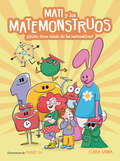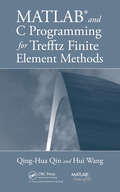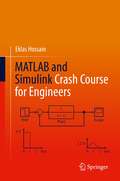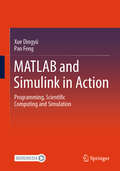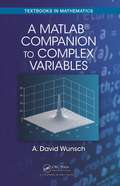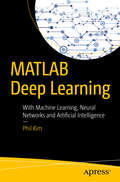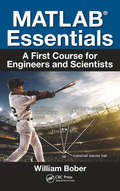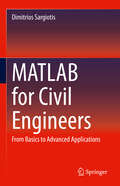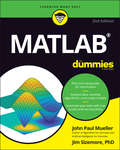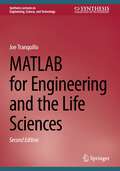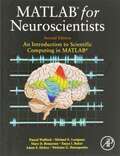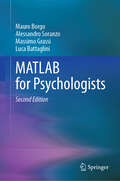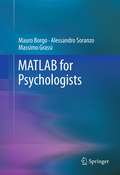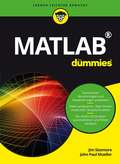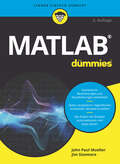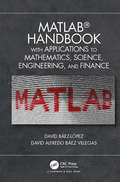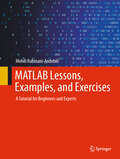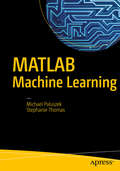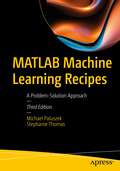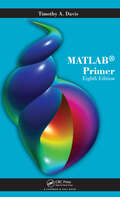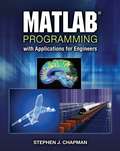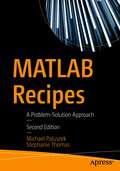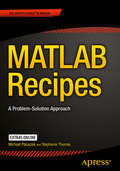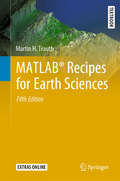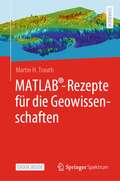- Table View
- List View
Mati y los Matemonstruos
by Clara GrimaCon Mati y los matemonstruos, ¡nadie tendrá miedo de las matemáticas! Miguel empieza un nuevo curso y sabe que este año se encontrará con esa asignatura a la que todos los mayores le tienen tanto miedo: las matemáticas. Por suerte, a su hermana Mati le encantan y se divierte mucho resolviendo todo tipo de problemas. Cuando Miguel le pregunta cuál es su secreto, Mati le muestra unas gafas maravillosas con las que pueden ver a unos peculiares personajes: los matemonstruos. Unos monstruos simpatiquísimos que les enseñarán matemáticas de una forma amena y divertida. Porque las matemáticas, aunque parezcan complicadas y nos den un poco de miedo, en realidad son divertidas y nos pueden ayudar a solucionar casi cualquier problema. *Este álbum despertará el gusto y la curiosidad por las matemáticas entre los lectores más jóvenes (5-7 años) *Perfecto para la preparación de primaria en edades tempranas. *Los niños aprenderán a pensar y mejorarán su comprensión lectora al mismo tiempo que aprenderán nuevos conceptos matemáticos. *Clara Grima es una matemática y profesora que divulga las matemáticas como algo divertido, fácil e imprescindible.
MATLAB and C Programming for Trefftz Finite Element Methods
by Qing-Hua Qin Hui WangAlthough the Trefftz finite element method (FEM) has become a powerful computational tool in the analysis of plane elasticity, thin and thick plate bending, Poisson's equation, heat conduction, and piezoelectric materials, there are few books that offer a comprehensive computer programming treatment of the subject. Collecting results scattered in t
MATLAB and Simulink Crash Course for Engineers
by Eklas HossainMATLAB and Simulink Crash Course for Engineers is a reader-friendly introductory guide to the features, functions, and applications of MATLAB and Simulink. The book provides readers with real-world examples, exercises, and applications, and offers highly illustrated, step-by-step demonstrations of techniques for the modelling and simulation of complex systems. MATLAB coverage includes vectors and matrices, programs and functions, complex numbers, visualization, solving equations, numerical methods, optimization problems, and graphical user interfaces. The Simulink coverage includes commonly used Simulink blocks, control system simulation, electrical circuit analysis, electric power systems, power electronics, and renewable energy technology. This powerful tutorial is a great resource for students, engineers, and other busy technical professionals who need to quickly acquire a solid understanding of MATLAB and Simulink.
MATLAB and Simulink in Action: Programming, Scientific Computing and Simulation
by Dingyü Xue Feng PanThe textbook is intended for teaching MATLAB language and its applications. The book is composed of three parts: MATLAB programming, scientific computing with MATLAB, and system simulation with Simulink. Since MATLAB is widely used in all fields of science and engineering, a good introduction to the language can not only help students learn how to use it to solve practical problems, but also provide them with the skills to use MATLAB independently in their later courses and research. The three parts of the book are well-balanced and tailored to the needs of engineering students, and the mathematical problems commonly encountered in engineering can be easily solved using MATLAB. This textbook is suitable for undergraduate and graduate students majoring in science and engineering.
A MatLab Companion to Complex Variables (Textbooks in Mathematics #41)
by A. David WunschThis book is intended for someone learning functions of a complex variable and who enjoys using MATLAB. It will enhance the exprience of learning complex variable theory and will strengthen the knowledge of someone already trained in ths branch of advanced calculus. ABET, the accrediting board for engineering programs, makes it clear that engineering graduates must be skilled in the art of programming in a language such as MATLAB®. Supplying students with a bridge between the functions of complex variable theory and MATLAB, this supplemental text enables instructors to easily add a MATLAB component to their complex variables courses.A MATLAB® Companion to Complex Variables provides readers with a clear understanding of the utility of MATLAB in complex variable calculus. An ideal adjunct to standard texts on the functions of complex variables, the book allows professors to quickly find and assign MATLAB programming problems that will strengthen students’ knowledge of the language and concepts of complex variable theory.The book shows students how MATLAB can be a powerful learning aid in such staples of complex variable theory as conformal mapping, infinite series, contour integration, and Laplace and Fourier transforms. In addition to MATLAB programming problems, the text includes many examples in each chapter along with MATLAB code.Fractals, the most recent interesting topic involving complex variables, demands to be treated with a language such as MATLAB. This book concludes with a Coda, which is devoted entirely to this visually intriguing subject.MATLAB is not without constraints, limitations, irritations, and quirks, and there are subtleties involved in performing the calculus of complex variable theory with this language. Without knowledge of these subtleties, engineers or scientists attempting to use MATLAB for solutions of practical problems in complex variable theory suffer the risk of making major mistakes. This book serves as an early warning system about these pitfalls.
MATLAB Deep Learning
by Phil KimThis book consists of six chapters, which can be grouped into three subjects. The first subject is Machine Learning and takes place in Chapter 1. Deep Learning stems from Machine Learning. This implies that if you want to understand the essence of Deep Learning, you have to know the philosophy behind Machine Learning to some extent. Chapter 1 starts with the relationship between Machine Learning and Deep Learning, followed by problem solving strategies and fundamental limitations of Machine Learning. The detailed techniques are not introduced yet. Instead, fundamental concepts that applies to both the neural network and Deep Learning will be covered. The second subject is artificial neural network. Chapters 2-4 focuses on this subject. As Deep Learning is a type of Machine Learning that employs a neural network, the neural network is inseparable from Deep Learning. Chapter 2 starts with the fundamentals of the neural network: principles of its operation, architecture, and learning rules. It also provides the reason that the simple single-layer architecture evolved to the complex multi-layer architecture. Chapter 3 presents the backpropagation algorithm, which is an important and representative learning rule of the neural network and also employed in Deep Learning. This chapter explains how cost functions and learning rules are related and which cost functions are widely employed in Deep Learning. Chapter 4 introduces how to apply the neural network to classification problems. We have allocated a separate section for classification because it is currently the most prevailing application of Machine Learning. For example, image recognition, one of the primary applications of Deep Learning, is a classification problem. The third topic is Deep Learning. It is the main topic of this book as well. Deep Learning is covered in Chapters 5 and 6. Chapter 5 introduces the drivers that enables Deep Learning to yield excellent performance. For a better understanding, it starts with the history of barriers and solutions of Deep Learning. Chapter 6 covers the convolution neural network, which is representative of Deep Learning techniques. The convolution neural network is second-to-none in terms of image recognition. This chapter starts with an introduction of the basic concept and architecture of the convolution neural network as it compares with the previous image recognition algorithms. It is followed by an explanation of the roles and operations of the convolution layer and pooling layer, which act as essential components of the convolution neural network. The chapter concludes with an example of digit image recognition using the convolution neural network and investigates the evolution of the image throughout the layers.
MATLAB® Essentials: A First Course for Engineers and Scientists
by William BoberAll disciplines of science and engineering use numerical methods for complex problem analysis, due to the highly mathematical nature of the field. Analytical methods alone are unable to solve many complex problems engineering students and professionals confront. Introduction to MATLAB® Programming for Engineers and Scientists examines the basic elements of code writing, and describes MATLAB® methods for solving common engineering problems and applications across the range of engineering disciplines. The text uses a class-tested learning approach and accessible two-color page design to guide students from basic programming to the skills needed for future coursework and engineering practice.
MATLAB for Civil Engineers: From Basics to Advanced Applications
by Dimitrios SargiotisThis book is a comprehensive and rigorous guide to MATLAB for Civil Engineers, bridging the critical gap between theoretical mathematics and practical engineering solutions. With an approachable introduction for students and deep insights for experienced professionals, it caters to a wide range of audiences across civil engineering disciplines—environmental, structural, geotechnical, and transportation engineering. Structured to guide readers progressively, the book begins with foundational MATLAB operations such as syntax and matrix manipulation, then advances into sophisticated engineering applications, including optimization, numerical methods, and data visualization. It covers essential MATLAB functionalities, offering detailed instruction on computation, visualization, and programming, all within the context of solving real-world engineering challenges. What sets this book apart is its hands-on approach. Readers are immersed in practical learning through real-world case studies, examples, and step-by-step exercises designed to reinforce key concepts. The text provides both academic and professional readers with the tools they need to model, analyze, and optimize engineering systems using MATLAB, ensuring they are equipped to handle both routine and complex engineering challenges with confidence. By the end, readers will not only master MATLAB's powerful tools but will also understand how to apply them directly to critical civil engineering problems, positioning themselves to innovate and lead in a field where computational proficiency is increasingly essential.
MATLAB For Dummies
by John Paul Mueller Jim SizemoreGo from total MATLAB newbie to plotting graphs and solving equations in a flash! MATLAB is one of the most powerful and commonly used tools in the STEM field. But did you know it doesn’t take an advanced degree or a ton of computer experience to learn it? MATLAB For Dummies is the roadmap you’ve been looking for to simplify and explain this feature-filled tool. This handy reference walks you through every step of the way as you learn the MATLAB language and environment inside-and-out. Starting with straightforward basics before moving on to more advanced material like Live Functions and Live Scripts, this easy-to-read guide shows you how to make your way around MATLAB with screenshots and newly updated procedures. It includes: A comprehensive introduction to installing MATLAB, using its interface, and creating and saving your first file Fully updated to include the 2020 and 2021 updates to MATLAB, with all-new screenshots and up-to-date procedures Enhanced debugging procedures and use of the Symbolic Math Toolbox Brand new instruction on working with Live Scripts and Live Functions, designing classes, creating apps, and building projects Intuitive walkthroughs for MATLAB’s advanced features, including importing and exporting data and publishing your work Perfect for STEM students and new professionals ready to master one of the most powerful tools in the fields of engineering, mathematics, and computing, MATLAB For Dummies is the simplest way to go from complete newbie to power user faster than you would have thought possible.
MATLAB for Engineering and the Life Sciences (Synthesis Lectures on Engineering, Science, and Technology)
by Joe TranquilloThis book is a self-guided tour of MATLAB for engineers and life scientists. It introduces the most commonly used programming techniques through biologically inspired examples. Although the text is written for undergraduates, graduate students and academics, as well as those in industry, will find value in learning MATLAB. The book takes the emphasis off of learning syntax so that the reader can focus more on algorithmic thinking. Although it is not assumed that the reader has taken differential equations or a linear algebra class, there are short introductions to many of these concepts. Following a short history of computing, the MATLAB environment is introduced. Next, vectors and matrices are discussed, followed by matrix-vector operations. The core programming elements of MATLAB are introduced in three successive chapters on scripts, loops, and conditional logic. The last three chapters outline how to manage the input and output of data, create professional quality graphics and find and use MATLAB toolboxes. Throughout, biomedical and life science examples are used to illustrate MATLAB's capabilities.
MATLAB for Neuroscientists: An Introduction to Scientific Computing in MATLAB
by Pascal Wallisch Michael E. Lusignan Marc D. Benayoun Tanya I. Baker Adam Seth Dickey Nicholas G. HatsopoulosMATLAB for Neuroscientists serves as the only complete study manual and teaching resource for MATLAB, the globally accepted standard for scientific computing, in the neurosciences and psychology. This unique introduction can be used to learn the entire empirical and experimental process (including stimulus generation, experimental control, data collection, data analysis, modeling, and more), and the 2nd Edition continues to ensure that a wide variety of computational problems can be addressed in a single programming environment. This updated edition features additional material on the creation of visual stimuli, advanced psychophysics, analysis of LFP data, choice probabilities, synchrony, and advanced spectral analysis. Users at a variety of levels―advanced undergraduates, beginning graduate students, and researchers looking to modernize their skills―will learn to design and implement their own analytical tools, and gain the fluency required to meet the computational needs of neuroscience practitioners.
MATLAB for Psychologists
by Mauro Borgo Alessandro Soranzo Massimo Grassi Luca BattagliniThe second edition of this textbook provides a comprehensive and detailed overview of MATLAB and specific tools for creating experiments and analysing data in psychology. In addition to an enhanced focus on connections with external devices and writing experiments, all chapters have been thoroughly revised and updated to provide the latest information and examples compatible with the most recent versions of MATLAB. All scripts have been tested to ensure a reliable and exact response. In addition, the book provides detailed examples of classic experiments (e.g., the Posner task) as well as recommendations for structuring and implementing ad hoc experiments. Each chapter is accompanied by several illustrations, examples, and code to match every reader's expertise and comfort level. This concise volume demonstrates MATLAB’s responsiveness to individuals’ research needs, whether the task is programming experiments, creating sensory stimuli, running simulations, or calculating statistics for data analysis. Key areas of coverage include: Thinking in a matrix way. Handling and plotting data. Guidelines for improved programming, sound, and imaging. Statistical analysis and signal detection theory. Psychophysics Toolbox and its use in connection with external devices. MATLAB for Psychologists, Second Edition, serves a wide audience of advanced undergraduate and graduate level psychology students, professors, and researchers as well as lab technicians and other professionals involved in programming psychology experiments.
MATLAB for Psychologists
by Alessandro Soranzo Mauro Borgo Massimo GrassiThe matrix laboratory interactive computing environment--MATLAB--has brought creativity to research in diverse disciplines, particularly in designing and programming experiments. More commonly used in mathematics and the sciences, it also lends itself to a variety of applications across the field of psychology. For the novice looking to use it in experimental psychology research, though, becoming familiar with MATLAB can be a daunting task. MATLAB for Psychologists expertly guides readers through the component steps, skills, and operations of the software, with plentiful graphics and examples to match the reader's comfort level. Using an extended illustration, this concise volume explains the program's usefulness at any point in an experiment, without the limits imposed by other types of software. And the authors demonstrate the responsiveness of MATLAB to the individual's research needs, whether the task is programming experiments, creating sensory stimuli, running simulations, or calculating statistics for data analysis. Key features of the coverage: Thinking in a matrix way.Handling and plotting data.Guidelines for improved programming, sound, and imaging.Statistical analysis and signal detection theory indexes.The Graphical User Interface.The Psychophysics Toolbox.MATLAB for Psychologists serves a wide audience of advanced undergraduate and graduate level psychology students, professors, and researchers as well as lab technicians involved in programming psychology experiments.
Matlab für Dummies (Für Dummies)
by Jim SizemoreOb Naturwissenschaftler, Mathematiker, Ingenieur oder Datenwissenschaftler - mit MATLAB haben Sie ein mächtiges Tool in der Hand, das Ihnen die Arbeit mit Ihren Daten erleichtert. Aber wie das mit manch mächtigen Dingen so ist - es ist auch ganz schön kompliziert. Aber keine Sorge! Jim Sizemore führt Sie in diesem Buch Schritt für Schritt an das Programm heran - von der Installation und den ersten Skripten bis hin zu aufwändigen Berechnungen, der Erstellung von Grafiken und effizienter Fehlerbehebung. Sie werden begeistert sein, was Sie mit MATLAB alles anstellen können.
Matlab für Dummies (Für Dummies)
by Jim Sizemore John Paul MuellerMATLAB® So lernen Sie MATLAB ideal zu nutzen Ob Naturwissenschaftler, Mathematiker, Ingenieur oder Datenwissenschaftler - mit MATLAB haben Sie ein mächtiges Tool in der Hand, das Ihnen die Arbeit mit Ihren Daten erleichtert. Aber wie das mit manch mächtigen Dingen so ist - es ist auch ganz schön kompliziert. Aber keine Sorge! Die Autoren führen Sie in diesem Buch Schritt für Schritt an das Programm heran - von der Installation und den ersten Skripten bis hin zu aufwändigen Berechnungen, der Erstellung von Grafiken und effizienter Fehlerbehebung. Sie werden begeistert sein, was Sie mit MATLAB alles anstellen können. Sie erfahren Was es mit dem MATLAB-Dateisystem auf sich hat Wie Sie mathematische Operationen mit Vektoren und Matrizen durchführen Wie Sie Funktionen und Skripte erstellen Wie Sie importieren, exportieren und publizieren.
MATLAB Handbook with Applications to Mathematics, Science, Engineering, and Finance
by Jose Miguel David Baez-Lopez David Alfredo Baez VillegasThe purpose of this handbook is to allow users to learn and master the mathematics software package MATLAB®, as well as to serve as a quick reference to some of the most used instructions in the package. A unique feature of this handbook is that it can be used by the novice and by experienced users alike. For experienced users, it has four chapters with examples and applications in engineering, finance, physics, and optimization. Exercises are included, along with solutions available for the interested reader on the book’s web page. These exercises are a complement for the interested reader who wishes to get a deeper understanding of MATLAB. <P><P>Features <P><P>Covers both MATLAB and introduction to Simulink <P><P>Covers the use of GUIs in MATLAB and Simulink <P><P>Offers downloadable examples and programs from the handbook’s website <P><P>Provides an introduction to object oriented programming using MATLAB <P><P>Includes applications from many areas <P><P>Includes the realization of executable files for MATLAB programs and Simulink models
MATLAB Lessons, Examples, and Exercises: A Tutorial for Beginners and Experts
by Mehdi Rahmani-AndebiliMATLAB Lessons, Examples, and Exercises: A Tutorial for Beginners and Experts is a book for anyone interested in learning MATLAB, a popular programming language used in mathematics, engineering, and science. Whether you’re a student, instructor, engineer, or technical professional, this book provides easy-to-follow lessons, examples, and exercises in each section of every chapter, emphasizing writing and executing code to help you become proficient in programming with MATLAB. Different colors make the code, outputs, and program descriptions more straightforward to read to improve reader comprehension. The book covers all the essential functions of MATLAB that are needed in math, engineering, and science, and it explains the math behind each function so you can apply them to solve real-world problems. Whether you’re new to programming or an expert, this book offers clear explanations, diverse examples, and hands-on exercises to help you improve your MATLAB programming skills and understand how to use MATLAB in various fields.
MATLAB Machine Learning
by Michael Paluszek Stephanie ThomasThis book is a comprehensive guide to machine learning with worked examples in MATLAB. It starts with an overview of the history of Artificial Intelligence and automatic control and how the field of machine learning grew from these. It provides descriptions of all major areas in machine learning. The book reviews commercially available packages for machine learning and shows how they fit into the field. The book then shows how MATLAB can be used to solve machine learning problems and how MATLAB graphics can enhance the programmer's understanding of the results and help users of their software grasp the results. Machine Learning can be very mathematical. The mathematics for each area is introduced in a clear and concise form so that even casual readers can understand the math. Readers from all areas of engineering will see connections to what they know and will learn new technology. The book then provides complete solutions in MATLAB for several important problems in machine learning including face identification, autonomous driving, and data classification. Full source code is provided for all of the examples and applications in the book. What you'll learn: An overview of the field of machine learning Commercial and open source packages in MATLAB How to use MATLAB for programming and building machine learning applications MATLAB graphics for machine learning Practical real world examples in MATLAB for major applications of machine learning in big data Who is this book for: The primary audiences are engineers and engineering students wanting a comprehensive and practical introduction to machine learning.
MATLAB Machine Learning Recipes: A Problem-Solution Approach
by Michael Paluszek Stephanie ThomasHarness the power of MATLAB to resolve a wide range of machine learning challenges. This new and updated third edition provides examples of technologies critical to machine learning. Each example solves a real-world problem, and all code provided is executable. You can easily look up a particular problem and follow the steps in the solution.This book has something for everyone interested in machine learning. It also has material that will allow those with an interest in other technology areas to see how machine learning and MATLAB can help them solve problems in their areas of expertise. The chapter on data representation and MATLAB graphics includes new data types and additional graphics. Chapters on fuzzy logic, simple neural nets, and autonomous driving have new examples added. And there is a new chapter on spacecraft attitude determination using neural nets. Authors Michael Paluszek and Stephanie Thomas show how all of these technologies allow you to build sophisticated applications to solve problems with pattern recognition, autonomous driving, expert systems, and much more.What You Will LearnWrite code for machine learning, adaptive control, and estimation using MATLABUse MATLAB graphics and visualization tools for machine learningBecome familiar with neural netsBuild expert systemsUnderstand adaptive controlGain knowledge of Kalman FiltersWho This Book Is ForSoftware engineers, control engineers, university faculty, undergraduate and graduate students, hobbyists.
MATLAB Primer
by Timothy A. DavisHighlighting the new aspects of MATLAB 7.10 and expanding on many existing features, this eighth edition continues to offer a hands-on, step-by-step introduction to using the powerful tools of MATLAB. It includes a new chapter on object-oriented programming, a new discussion of the MATLAB File Exchange window, major changes to the MATLAB Editor, and an explanation of more powerful Help tools. It also presents a synopsis of the most frequently used functions, operators, and special characters-providing quick and easy access to frequently used information. M-files and MEX-files for large examples are available at www.crcpress.com
MATLAB Programming with Applications for Engineers
by Stephen J. ChapmanThis textbook seeks to simultaneously teach MATLAB as a technical programming language while introducing the student to many of the practical functions that make solving problems in MATLAB so much easier than in other languages. It provides a complete introduction to the fundamentals of good procedural programming and aids students in developing good design habits that will serve them well in any other language that they may pick up later.
MATLAB Recipes: A Problem-Solution Approach
by Michael Paluszek Stephanie ThomasLearn from state-of-the-art examples in robotics, motors, detection filters, chemical processes, aircraft, and spacecraft. With this book you will review contemporary MATLAB coding including the latest MATLAB language features and use MATLAB as a software development environment including code organization, GUI development, and algorithm design and testing. Features now covered include the new graph and digraph classes for charts and networks; interactive documents that combine text, code, and output; a new development environment for building apps; locally defined functions in scripts; automatic expansion of dimensions; tall arrays for big data; the new string type; new functions to encode/decode JSON; handling non-English languages; the new class architecture; the Mocking framework; an engine API for Java; the cloud-based MATLAB desktop; the memoize function; and heatmap charts. MATLAB Recipes: A Problem-Solution Approach, Second Edition provides practical, hands-on code snippets and guidance for using MATLAB to build a body of code you can turn to time and again for solving technical problems in your work. Develop algorithms, test them, visualize the results, and pass the code along to others to create a functional code base for your firm. What You Will Learn Get up to date with the latest MATLAB up to and including MATLAB 2020bCode in MATLAB Write applications in MATLAB Build your own toolbox of MATLAB code to increase your efficiency and effectiveness Who This Book Is For Engineers, data scientists, and students wanting a book rich in examples using MATLAB.
MATLAB Recipes
by Stephanie Thomas Michael PaluszekLearn from state-of-the-art examples in robotics, motors, detection filters, chemical processes, aircraft, and spacecraft. MATLAB Recipes: A Problem-Solution Approach is a practical reference for industry engineers using MATLAB to solve everyday problems. With this book you will review contemporary MATLAB coding including the latest language features and use MATLAB as a software development environment including code organization, GUI development, and algorithm design and testing. This book provides practical guidance for using MATLAB to build a body of code you can turn to time and again for solving technical problems in your line of work. Develop algorithms, test them, visualize the results, and pass the code along to others to create a functional code base for your firm. What you'll learn Learn how to build industrial-strength toolboxes Move beyond a folder of scripts and create well-organized, reusable MATLAB code modules Leverage MATLAB as an IDE and not just a programming language Build a functional code base for your company or department Create your own GUIs for repeatable workflows Who this book is for This book is written for engineers and scientists who use MATLAB on a regular basis and who want to take their coding to a higher level, i. e. people who want to make commercial-quality MATLAB toolboxes. This book may be used by students who are required to use MATLAB for their courses and projects as well as professionals who use MATLAB to solve problems on the job. Table of Contents Part I: Coding in MATLAB 1. Coding Basics 2. MATLAB Style 3. Visualization 4. Interactive Graphics 5. Testing and Debugging Part II: Applications 6. The Double Integrator 7. Robotics 8. Electrical Motor 9. Fault Detection 10. Chemical Processes 11. Aircraft 12. Spacecraft
MATLAB® Recipes for Earth Sciences: Matlab® And Design Recipes For Earth Sciences (Springer Textbooks in Earth Sciences, Geography and Environment)
by Martin H. TrauthMATLAB® is used in a wide range of geoscientific applications, e.g. for image processing in remote sensing, for creating and processing digital elevation models, and for analyzing time series. This book introduces readers to MATLAB-based data analysis methods used in the geosciences, including basic statistics for univariate, bivariate and multivariate datasets, time-series analysis, signal processing, the analysis of spatial and directional data, and image analysis. The revised and updated Fifth Edition includes seven new sections, and the majority of the chapters have been rewritten and significantly expanded. New sections include error analysis, the problem of classical linear regression of log-transformed data, aligning stratigraphic sequences, the Normalized Difference Vegetation Index, Aitchison’s log-ratio transformation, graphical representation of spherical data, and statistics of spherical data. The book also includes numerous examples demonstrating how MATLAB can be used on datasets from the earth sciences. The supplementary electronic material (available online through SpringerLink) contains recipes that include all the MATLAB commands featured in the book and the sample data.
MATLAB®-Rezepte für die Geowissenschaften
by Martin H. TrauthTrauth, Martin H.MATLAB® - Rezepte für Geowissenschaften, 1. deutschsprachige Auflage, basierend auf der korrigierten 5. englischsprachigen AuflageMATLAB® wird in einer Vielzahl von geowissenschaftlichen Anwendungen eingesetzt, z.B. zur Bildverarbeitung in der Fernerkundung, zur Erzeugung und Verarbeitung digitaler Höhenmodelle und zur Analyse von Zeitreihen. Dieses Buch führt in Methoden der Datenanalyse in den Geowissenschaften mit MATLAB ein, wie z.B. grundlegende Statistik für univariate, bivariate und multivariate Datensätze, Zeitreihenanalyse, Signalverarbeitung, die Analyse räumlicher und gerichteter Daten und Bildanalyse. Der Text enthält zahlreiche Beispiele, die zeigen, wie MATLAB auf Datensätze aus den Geowissenschaften angewendet werden kann. Das ergänzende elektronische Material des Buches (online verfügbar über Springer Link) enthält Rezepte, die alle im Buch vorgestellten MATLAB-Befehle und die Beispieldaten enthalten. Das Buch soll Student:innen, Doktorand:innen, Postdoktorand:innen und Fachleuten helfen, schnelle Lösungen für gängige Datenanalyseprobleme in den Geowissenschaften zu finden.SystemanforderungenBenutzer:innen dieses Buches benötigen die MATLAB®-Software, die für Windows, macOS und Linux verfügbar ist. Die M-Files und Beispieldaten, die online über Springer Link verfügbar sind, sollten auf allen Plattformen laufen, ohne dass eine Modifikation erforderlich ist. Für diese Ausgabe haben wir MATLAB Version 9.11 (Release 2021b), die Bioinformatics Toolbox Version 4.15.2, die Image Processing Toolbox Version 11.4, die Mapping Toolbox Version 5.2, die Signal Processing Toolbox Version 8.7, Simulink 3D Animation Version 9.3, die Statistics and Machine Learning Toolbox Version 12.2 und die Wavelet Toolbox Version 6.0 verwendet.
